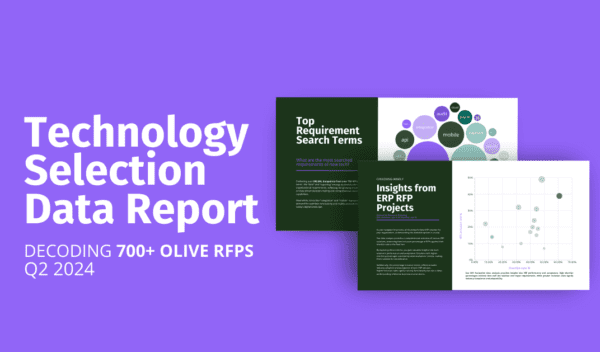How to Choose the Right Enterprise Payroll Software Vendor
49% of employees are willing to leave a job due after encountering 2 or more salary errors. Payroll software is one of those things where if you’ve chosen the right solution for your business, you hear very little about it but if you get it wrong, you may as well have offended every member of staff. Whether your accountants, CIOs, or outside providers are responsible, everyone wants efficiency and accuracy.
The problem, however, is that there are so many options, it is impossible to tell which fits. The time it takes to evaluate options and sift through broken promises of vendors has meant the process of finding payroll software has gotten out of hand. Your large business simply doesn’t have the time to do the extensive groundwork.
Even if you have frustrating software, it seems easier to keep it than rock the cradle. The devil you know is better than the devil you don’t, right?
Olive understands the risks of going to the market to upgrade software and the patience it requires. Few things cause turmoil like salary error. Simply put, financial disorganization in a large company is unforgivable. Career risk, compliance issues, taxation and data usage are almost after-thoughts despite being serious threats.
Choosing the right payroll software doesn’t need to be the minefield it is currently regarded as. Your organization might just have been looking in the wrong place. Olive was founded to transform the buyer – seller dynamic and dramatically shorten and digitize the process of software selection. We help clients reduce their procurement process from months to weeks and find a payroll solution that works. That is the difference we provide!
Payroll Software Benefits
A streamlined and functional Payroll system eases the workload of paying your valued team. The larger the organization, the more valuable the system. To pay using any other system becomes expensive or inefficient which is the same thing. Some of the benefits include:
– Improved Efficiency and Reduced HRM costs – The HR team who are typically responsible for processing payments do not become obsolete after implementing a new system. Far from it. Installing payroll software improves the use of their time dramatically reducing the salaried hours spent on an inefficient system. As much as 80% of the processing costs are saved with an efficient system.
– Employee Satisfaction – Circumventing the potential employee loss from payroll errors allows your company to retain staff for longer. Hiring costs are reduced, specialization and expertize increase due to sustained teams.
– Increased Revenue – With the right payroll system it can be easily tracked which projects are demanding more of your team’s time. Knowing which projects are more expensive can determine an informed pricing model. Similarly, better tracking of hours cuts down errors of excessive billing to clients.
How to Choose the Right Enterprise Payroll Solution
For many IT leaders, locating the right payroll solution has caused a deep sigh. Incongruence has developed between market providers and prospective buyers. Everyone wants to sell you their all-conquering options without taking onboard your actual needs. It is the opposite of what the process ought to be.
1) The Business Needs Come First
A large organization will draw proposals from every type of Payroll company but it is your job to decide what you need most from your options. Of course, the streamlined, automated processing of accurate salaries is part and parcel of any self-respecting system. However, what are some of the other requirements you might need?
– Tracking time and attendance
– Gathering time-off requests
– Collecting and submitting new hire information
– Calculating and withholding pre and post-pay tax deductions
– Exporting data or operate with other systems such as HCM software
– Easy to fix mistakes
– Update you on tax laws and deadlines
– Employee record management
– Generate end-of-year employee earnings statements
2) Define and Rank Your Priorities
The aforementioned list presents the potential needs a large enterprise experiences but these are not specific to you and that is what matters. Determining your exact priorities and putting them in a ranked order informs the process, making your solution personalized.
– What are the non-negotiables?
– What would be a nice ancillary benefit but is not crucial?
– What areas of our enterprise need the benefit of payroll the most?
– What level of security is required?
– How are the users represented in the process?
It can be pretty simple to breeze through this part but there needs to be collaboration. Are HR and accounting singing from the same hymn sheet? Will your new system help employees or add work? A collaborative dialogue benefits everyone saving implementation resistance in the long run.
3) Gather the Market Options
Step 3 in the search for your Payroll paragon is to cast the net far and wide. Capture as many solutions as possible. Discard the obviously unfit software, but try to stay relatively shallow in this stage.
Perhaps consider using a market evaluation website where you get a list of solutions and their comparative features. However, be wary as often the featured options pay to be there and thus influence what you see. A perfectly fitted option might exist outside of this platform but be downgraded due to bias.
4) Shortlisting
Shortlisting your vendor solutions can mean saying goodbye to intriguing solutions but if they don’t improve your business, they have got to go. Aiming to filter the long list down to 3-5 solutions is optimal as it gives you a realistic endeavor of putting them through a rigorous but stomach-able evaluation.
The most obvious place to start is dealing with your budget. Truthfully, the budget may be decided before gathering the larger list. Having it in step 4 allows you to stay flexible for truly outstanding options.
Perpetual licenses, monthly outsourced retainers, or subscription plus per monthly rates are the typical price structures to expect. Depending on the organization, different setups make sense.
Rather than picking an arbitrary number, you are happy with paying, make sure to weigh the investment against the cost savings. Salaried HR hours, HCM hours, end of year reporting fees and more are part of the potential cost savings and should be factored in. What is the ROI available?
With your budgeting set, it becomes easier to eliminate unfeasible options leaving you to weigh the rest on merits. The next filters to consider ought to be:
– Priorities: How does each option serve my priority needs?
– Compatibility: Can they work with my accountancy and HCM software?
– Cloud Distribution: Can everyone with a need to access it, access it at all times from anywhere?
– Scaling: If we increase or decrease, can the software handle it? Will the pricing structure differ?
– Customer Care: How quickly do issues get resolved? Is there a 24/7 line?
– Extras: What benefits does it come with that we didn’t anticipate?
– Impact: Will this cause a positive impact to my team and bottom line?
5) Evaluation and Selection
Through Step 4 you have refined your list down to the realistic contenders. Hopefully, this has left you with a maximum of 5 to choose between; otherwise, it will likely get frustrating with the time consumption.
Through step 5 it is important to remember that traditionally the sales dynamic has favored sellers who became used to an easy evaluation process. The relationship skewed so much so that very little content exists on satisfying your priorities and more about the features they offer. It is not a slight on the market by any stretch, but an awareness to not slide into this position and forget your priority needs.
Try not to lose any steam in this section as you delve into the reputations and usability of each offering. You are well within your rights to ask a vendor for references, reviews, and any other materials that help you make your decision.
Most importantly, ask for a demo! Vendors are quite accommodating and not doing so is ill-advised.
Remember the days when we could travel? Not doing a demo would be the same as packing your suitcase for a sun holiday when you were booked for Everest Basecamp. You should have what you need before you arrive otherwise it can be a flop.
Bring a teammate and have questions prepared for yourself and the vendor throughout the process.
– How do you address my priorities?
– Which vendor really listened to your demands?
– Who spent more time on irrelevant features than your outcomes?
– What is the after-sale package?
– Which services caught your attention and why?
Undoubtedly you will lean toward one or two vendors. Revisit your ranked priorities once more and the user fit for each demo participant. How well would your team be served? This is the final step of your due diligence. It can be taxing but it is ultimately worth it in the long run. Do what you can to avoid cutting any corners or taking shortcuts. Operational efficiency and team satisfaction is the result.
Olive Helps You Find an Enterprise Payroll Software Solution in 66% Less Time
While the market of payroll solutions is flooded with eager providers, it has nearly becomes a non-starter for large organizations to consider adopting a new system. The loss of time, improper options and various other pitfalls dampen the potential ROI.
Olive works on your behalf to find the most efficient solution suited to your enterprise. Our process is saving exceptional amounts of time and money for our clients. Cut out the wastage by recruiting a solution who listens to your needs, collaborates with your team and then finds the right match.
Whether you have 20 team members or 500, we are experts in cutting through the noise and wading through the ill-fitting alternatives to return the most success-inducing option. Our opinion is free from bias and only influenced by the best outcomes for our clients!





